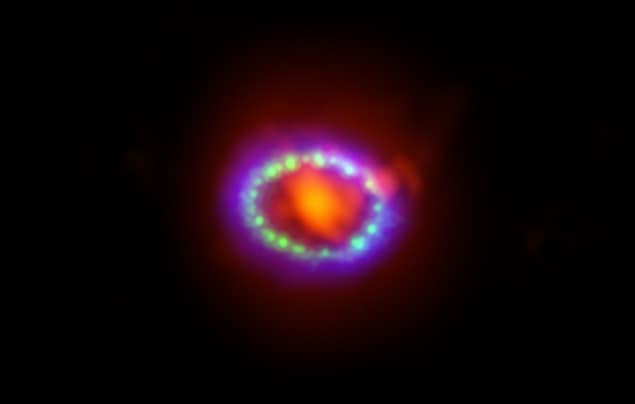
The effect of gravity on virtual electron–positron pairs as they propagate through space could lead to a violation of Einstein’s equivalence principle, according to calculations by James Franson at the University of Maryland, Baltimore County. While the effect would be too tiny to be measured directly using current experimental techniques, it could explain a puzzling anomaly observed during the famous SN1987 supernova of 1987.
In modern theoretical physics, three of the four fundamental forces – electromagnetism, the weak nuclear force and the strong nuclear force – are described by quantum mechanics. The fourth force, gravity, does not currently have a quantum formulation and is best described by Einstein’s general theory of relativity. Reconciling relativity with quantum mechanics is therefore an important and active area of physics.
An open question for theoretical physicists is how gravity acts on a quantum object such as a photon. Astronomical observations have shown repeatedly that light is attracted by a gravitational field. Traditionally, this is described using general relativity: the gravitational field bends space–time, and the light is slowed down (and slightly deflected) as it passes through the curved region. In quantum electrodynamics, a photon propagating through space can occasionally annihilate with itself, creating a virtual electron–positron pair. Soon after, the electron and positron recombine to recreate the photon. If they are in a gravitational potential then, for the short time they exist as massive particles, they feel the effect of gravity. When they recombine, they will create a photon with an energy that is shifted slightly and that travels slightly slower than if there was no gravitational potential.
Irreconcilable differences
Franson scrutinized these two explanations for why light slows down as it passes through a gravitational potential. He decided to calculate how much the light should slow down according to each theory, anticipating that he would get the same answer. However, he was in for a surprise: the predicted changes in the speed of light do not match, and the discrepancy has some very strange consequences.
Franson calculated that, treating light as a quantum object, the change in a photon’s velocity depends not on the strength of the gravitational field, but on the gravitational potential itself. However, this leads to a violation of Einstein’s equivalence principle – that gravity and acceleration are indistinguishable – because, in a gravitational field, the gravitational potential is created along with mass, whereas in a frame of reference accelerating in free fall, it is not. Therefore, one could distinguish gravity from acceleration by whether a photon slows down or not when it undergoes particle–antiparticle creation.
An important example is a photon and a neutrino propagating in parallel through space. A neutrino cannot annihilate to create an electron–positron pair, so the photon will slow down more than the neutrino as they pass through a gravitational field, potentially letting the neutrino travel faster than light through that region of space. However, if the problem is viewed in a frame of reference falling freely into the gravitational field, neither the photon nor the neutrino slows down at all, so the photon continues to travel faster than the neutrino.
Two neutrino pulses?
While the idea that the laws of physics can be dependent on one’s frame of reference seems nonsensical, it could explain an anomaly in the 1987 observation of supernova SN1987a. An initial pulse of neutrinos was detected 7.7 hours before the first light from SN1987a reached Earth. This was followed by a second pulse of neutrinos, which arrived about three hours before the supernova light. Supernovae are expected to emit large numbers of neutrinos and the three-hour gap between the second burst of neutrinos and the arrival of the light agrees with the current theory of how a star collapses to create a supernova.
The first pulse of neutrinos is generally thought to be unrelated to the supernova. However, the probability of such a coincidence is statistically unlikely. If Franson’s results are correct, then the 7.7-hour gap between the first pulse of neutrinos and the arrival of the light could be explained by the gravitational potential of the Milky Way slowing down the light. This does not explain why two neutrino pulses preceded the light, but Franson suggests the second pulse could be related to a two-step collapse of the star.
Scepticism needed
Nevertheless Franson is cautious, insisting that “there are very serious reasons to be sceptical about this and the paper doesn’t claim that it’s a real effect, only that it’s a possibility.” He is also pessimistic about the prospects for the idea being proven or refuted in the near future, saying that the chances of another supernova so close are very low, and other possible tests do not presently have sufficient accuracy to detect the effect.
Raymond Chiao of the University of California, Merced, agrees with Franson that, observationally and experimentally, “there are a lot of caveats that need to be clarified,” most notably, that if Franson’s hypothetical interpretation of SN1987a is correct, there are two clear neutrino pulses separated by five hours, but little evidence of two corresponding pulses of light. Nevertheless, he says “There is a deep seated conceptual tension between general relativity and quantum mechanics…If, in fact, Franson is right, that is a huge, huge step in my opinion: it’s the tip of the iceberg element that quantum mechanics is correct and that general relativity must be wrong.”
The research is published in the New Journal of Physics.



